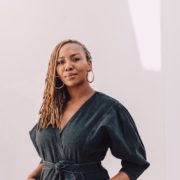Seven years ago Tometi helped to create what is possibly the biggest protest movement in US history. She explains what the critics of BLM get wrong, how her family’s story made her an activist and why she is certain the movement will succeed
Maybe Opal Tometi is not the image of a great US civil rights leader that lives in your head. For a start, she is not an austere man in a dark suit, but a 36-year-old woman in pilates gear, who laughs often and generously. She doesn’t need the sonorous tones of a Southern Baptist preacher to make her point – she has social media – and with Nigerian-born parents her ancestors were not among those enslaved and transported across the Atlantic several centuries ago. Yet, as one of the three founders of Black Lives Matter, Opal Tometi has helped to reignite the civil rights movement.
BLM was formed in 2013 when Oakland-based organiser Alicia Garza felt moved to respond to the acquittal of George Zimmerman. Zimmerman had the year before shot dead an unarmed black teenager, Trayvon Martin, in Florida, and Garza posted an impassioned message on Facebook. Patrisse Cullors shared the post with the hashtag #BlackLivesMatter, and an inspired Tometi built the BlackLivesMatter.com website, choosing yellow and black as its signature colours. And with that a movement was born.
— Credits & Context
Featured Image, Bethany Mollenkof/The Guardian
Full article @ The Guardian
Black Lives Matter (BLM)
Black Lives Matter (BLM) is a decentralized political and social movement advocating for non-violent civil disobedience in protest against incidents of police brutality and all racially motivated violence against black people. The broader movement and its related organizations typically advocate against police violence towards black people, as well as for various other policy changes considered to be related to black liberation.
In July 2013, the movement began with the use of the hashtag #BlackLivesMatter on social media after the acquittal of George Zimmerman in the shooting death of African-American teen Trayvon Martin 17 months earlier, in February 2012. The movement became nationally recognized for street demonstrations following the 2014 deaths of two African Americans: Michael Brown—resulting in protests and unrest in Ferguson, Missouri, a city near St. Louis—and Eric Garner in New York City. Since the Ferguson protests, participants in the movement have demonstrated against the deaths of numerous other African Americans by police actions or while in police custody. In the summer of 2015, Black Lives Matter activists became involved in the 2016 United States presidential election. The originators of the hashtag and call to action, Alicia Garza, Patrisse Cullors, and Opal Tometi, expanded their project into a national network of over 30 local chapters between 2014 and 2016. The overall Black Lives Matter movement is a decentralized network of activists with no formal hierarchy.
Source – Black Lives Matter (Updated: 24 September 2020) Wikipedia. Available at https://en.wikipedia.org/wiki/Black_Lives_Matter, (Accessed: 25 September 2020)

